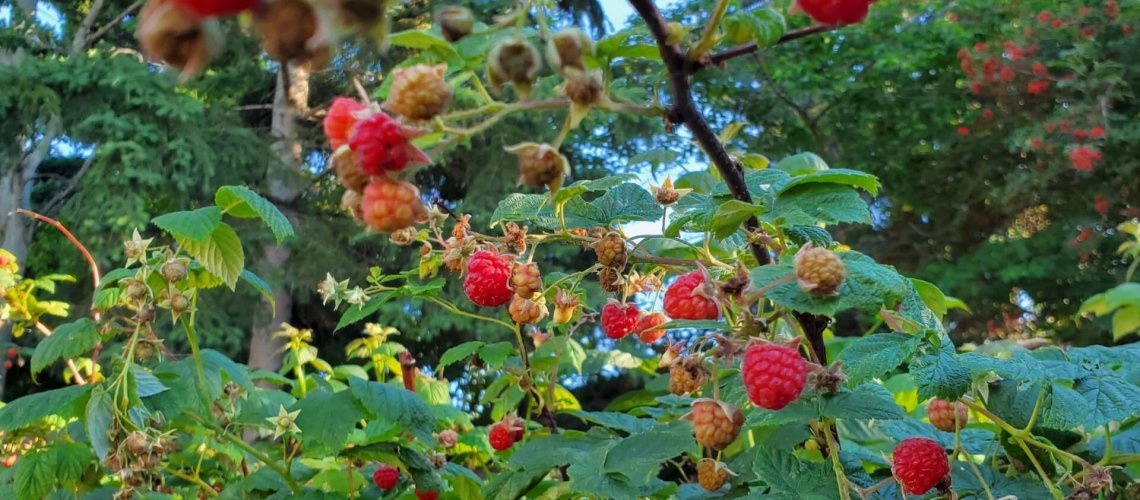Fine fruit is the flower of commodities. It is the most perfect union of the useful and the beautiful that the earth knows. Trees full of soft foliage; blossoms fresh with spring bounty; and, finally, fruit, rich, bloom-dusted, melting, and luscious – Andrew Jackson Downing
When purchasing trees, shrubs, or berry bushes, make sure they thrive in our Zone 3 climate. Shrubs and most trees need at least 5 hours of sunlight a day.
Most urban lots are too small for large trees. Choose smaller ones such as columnar aspen, crab apple, hawthorn, or mountain ash. Or buy dwarf trees. Place your trees where you can see them from inside the house. Don’t place them close to your windows.
Choose shrubs for their foliage as well as their flowers. Some such as the cotoneaster make excellent hedges. Others such as lilac, spiraea, ninebark, and potentilla are grown for both leaves and flowers. Others such as dogwood and berry bushes help to feed birds. Other attractive shrubs include butterfly bush, mock orange, and rose.
Fruit trees not only provide you with tasty organic food, but spring blossoms are beautiful. First check with your local market garden as to what varieties produce the best fruit and how long before they produce a good crop. Choose semi-dwarf or dwarf trees that grow up to no more than 15 feet tall. Short trees make easier picking. Apple, crab apple, Pembina plum, and Evans cherry are excellent Zone 3 fruit trees.
Berry bushes flower in the spring, fruit in the summer, and beautify the fall with the reds and yellows of their leaves. All make tasty jams, jellies, or pancake syrup. Some such are served in pies or as fruit. All are highly nutritious. While all berry bushes produce best in a sunny location, they tolerate partial shade.
Blueberries need two varieties in close proximity to successfully pollinate. They need an acidic soil, pH up to 5.5, and may take up to 8 years to reach full production.
Chokecherry is native to Canada. After a mass of white flowers, its fruits into a pitted sour berry that puckers the inside of your mouth.
Highbush cranberry has attractive leaves, clusters of white flowers, bright red clusters of berries, and beautiful red leaves in the fall. The bush is a cross-pollinating plant and therefore needs another variety close by.
Currents grow about four to five feet in height. They do not like hot dry soil; make sure they get enough water. Red Currents bear fruit on two-to-four-year-old wood, black currents bear on one or two-year-old wood.
Haskaps produce oddly shaped berries that are high in antioxidants. Plant in fertile, well-drained soil. They will grow up to 7 feet and require pruning to control their growth. Two compatible varieties are needed for cross-pollination.
Pin cherry is a large bush or a small tree native to Canada. In the spring it is filled with a mass of white blossoms that set into bright red berries.
Raspberries prefer a slightly acidic soil. When buying canes, check to see if the canes are summer or fall-bearing canes.
Saskatoons are tall and can reach 16 or more feet in height.
When planting a tree, shrub, or bush, dig a hole twice as wide as the root ball and set the thicker part of the stem just above the ground level. Fill the hole with the excavated dirt, and tamp the soil thoroughly around the roots; air voids may kill off the rootlets. To help develop the roots, add a cup of bone meal to the soil placed around the roots. For trees, don’t add compost as the roots may not spread properly, preferring the richer soil. Bushes have a more compact root structure so you can add compost to the hole. Once transplanted, water as required every 10 days for two to three years until it is well established.

Recent Comments